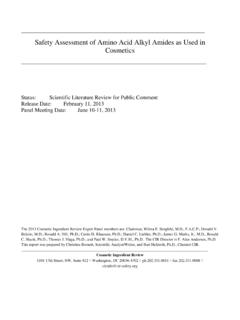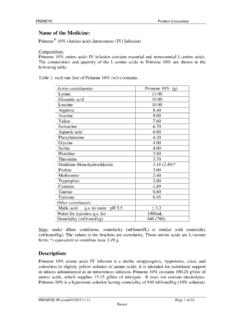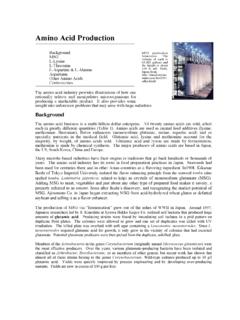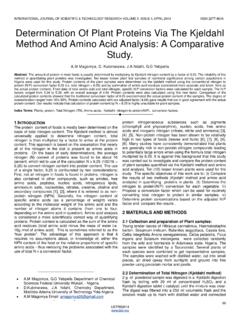Transcription of ISSN 0254-4725 Dietary protein quality FOOD AND FAO ...
1 issn 0254-4725 . Dietary protein quality FAO. FOOD AND. NUTRITION. evaluation in human PAPER. nutrition 92. Report of an FAO Expert Consultation Dietary protein quality FAO. FOOD AND. evaluation in NUTRITION. PAPER. human nutrition 92. Report of an FAO Expert Consultation 31 March 2 April, 2011. Auckland, New Zealand FOOD AND AGRICULTURE ORGANIZATION OF THE UNITED NATIONS. ROME, 2013. The designations employed and the presentation of material in this information product do not imply the expression of any opinion whatsoever on the part of the Food and Agriculture Organization of the United Nations (FAO) concerning the legal or development status of any country, territory, city or area or of its authorities, or concerning the delimitation of its frontiers or boundaries. The mention of specific companies or products of manufacturers, whether or not these have been patented, does not imply that these have been endorsed or recommended by FAO in preference to others of a similar nature that are not mentioned.
2 The views expressed in this information product are those of the author(s) and do not necessarily reflect the views of FAO. ISBN 978-92-5-107417-6. All rights reserved. FAO encourages reproduction and dissemination of material in this information product. Non-commercial uses will be authorized free of charge, upon request. Reproduction for resale or other commercial purposes, including educational purposes, may incur fees. Applications for permission to reproduce or disseminate FAO copyright materials, and all queries concerning rights and licences, should be addressed by e-mail to or to the Chief, Publishing Policy and Support Branch, Office of Knowledge Exchange, Research and Extension, FAO, Viale delle Terme di Caracalla, 00153 Rome, Italy. FAO 2013. iii Acknowledgements The committee would like to thank Dr Shane Rutherfurd of the Riddet Institute, Massey University, New Zealand for supplying data for the exemplar calculations of DIAAS and Dr Joyce Boye of Agriculture and Agri-Food Canada, for providing the examples of the calculation of DIAAS given in Section IV (2) of the report.
3 We also thank Mrs Terri Palmer of the Riddet Institute, Massey University, for secretarial assistance. v Table of contents Acknowledgements iii Acronyms ix Chapter 1. INTRODUCTION 1. Chapter 2. SUMMARY OF KEY FINDINGS FROM THE 2011 FAO. EXPERT CONSULTATION ON protein quality EVALUATION IN. HUMAN NUTRITION 3. key findings 3. Chapter 3. BACKGROUND TO THE CONSULTATION 7. major scientific reviews of protein quality evaluation methodology 7. - Introduction 7. airlee conference (1981) 8. deliberations of the codex committee on vegetable proteins regarding protein quality assessment (1982-1989) 8. joint fao/who expert consultation on protein quality evaluation (1989) 9. - amino acid analysis of foods 10. - amino acid requirements and scoring pattern 11. - Digestibility considerations 11. - Overall recommendation of the FAO/WHO 1989 Expert Consultation (published 1991) 12.
4 Fao/who/unu expert consultation on protein and amino acid requirements in human nutrition (rome 2001, geneva 2002, published as a who/fao/unu report in 2007) 12. - Overall recommendation 14. - The 2011 FAO Consultation 17. Chapter 4. FINDINGS AND RECOMMENDATIONS OF THE 2011 FAO EXPERT. CONSULTATION ON protein quality EVALUATION IN HUMAN. NUTRITION 19. significance and appropriateness of pdcaas in practice and truncation of pdcaas 19. - The digestible indispensable amino acid score (DIAAS) 20. - Practical application of the DIAAS 21. vi example calculations of diaas and the expression of digestible amino acid contents of foods 22. - Digestible amino acid contents 22. - Calculation of DIAAS 22. - Example of calculation of DIAAS for a single food ingredient 23. - Example of calculation of DIAAS for a food mixture 23. background to the validity of the amino acid scoring patterns 23.
5 - Definition of Dietary indispensable amino acid scoring patterns to be used in the calculation of DIAAS from immediately post infancy to adulthood 23. - Breast milk pattern 28. - Pattern for preschool and older children and adults: historical perspective 28. - Calculation of the scoring patterns from amino acid requirement values 30. - Optimal amino acid requirements 31. correction for amino acid digestibility and availability in the calculation of diaas 32. - Bioavailability of amino acids 32. - Digestibility: amino acids 33. - Chemical availability of amino acids 37. - Loss of bioavailability due to the presence of interfering substances 38. considerations regarding the use of bioassays to determine protein quality 38. - Postprandial protein utilization (PPU) 39. - Net postprandial protein utilization (NPPU) 39. - Application of the IAAO method to determine the metabolic availability (MA) of amino acids 40.
6 amino acid analysis and true amino acid digestibility/. bioavailability methodologies 41. - amino acid analysis methodology 41. - True amino acid digestibility/availability assays 41. bioactive components intrinsically associated with food proteins including those occurring naturally or formed during processing 42. diaas regulatory issues 42. recommendations for further research 44. - Human amino acid requirements 44. - Analytical 45. - Ileal digestibility 45. - Evaluation and perfection of techniques to directly measure the bioavailability of protein bound Dietary amino acids in humans 45. vii - Impact of interaction between bioactive factors and protein quality and function 46. - Communication 46. - Animal and plant breeding, food preparation and processing effects 46. strength of evidence used in making the recommendations 46.
7 - Preamble 46. - A hierarchy of evidence 47. - Strength of evidence pertaining to this consultation 48. Appendices 51. Appendix I: fao expert consultation on protein quality evaluation 51. Appendix II: attendance at the expert consultation on protein quality in human nutrition 55 References 57. List of tables TABLE 1. Calculation of DIAAS value for whole milk powder (WMP) 24. TABLE 2. Calculation of DIAAS value for a mixture of wheat, peas and whole milk powder 25. TABLE 3. amino acid scoring patterns for toddlers, children, adolescents and adults (amended values from the 2007 WHO/FAO/UNU report) 27. TABLE 4. Dietary indispensable amino acid profile of human milk 28. TABLE 5. Recommended amino acid scoring patterns for infants, children and older children, adolescents and adults 29. TABLE 6. Example of the use of DIAAS for protein quality assessment in the context of making claims 44 viii Dietary protein quality evaluation in human nutrition: Report of an FAO Expert Consultation List of figures FIGURE 1.
8 Model of protein metabolism in humans from WHO/FAO/UNU (2007) 7 FIGURE 2. Framework depicting short- and long-term potential protein quality related health outcomes. This indicates the need to look beyond physiological and metabolic responses in assessing health effects 26 Figure 3. Ranking of the validity of types of evidence for establishing Dietary fatty acid requirements (favourability decreasing from left to right) 47. ix Acronyms FAO Food and Agriculture Organization of the United Nations WHO World Health Organisation PDCAAS protein Digestibility Corrected amino acid Score DIAAS Digestible Indispensable amino acid Score IAA Indispensable amino Acids UNU United Nations University USDA United States Department of Agriculture PER protein Efficiency Ratio RNPR Relative Net protein Ratio method CCVP Codex Committee on Vegetable Proteins NPR Net protein Ratio NPU Net protein Utilization BV Biological Value INCAP Institute of Nutrition of Central America and Panama HPLC High Performance Liquid Chromatography CV Coefficient of Variation PITC Phenylisothiocyanate NSP Non-starch polysaccharide AOAC Association of Official Analytical Communities AA amino acid DIAA Digestible Indispensable amino acid IAA Indispensable amino acid WMP Whole
9 Milk Powder Lys Lysine SAA Sulphur amino acid Thr Threonine Trp Tryptophan CVDs Cardiovascular diseases His Histidine Leu Leucine AAA Aromatic amino Acids x Val Valine Met Lysine Cys Cystine Phe Phenylalanine Met Methionine Tyr Tyrosine Ile Isoleucine PPU Postprandial protein Utilisation NPPU Net Postprandial protein Utilization MA Metabolic Availability IAAO Indicator amino acid Oxidation IDAA Indispensable Dietary amino acid EAR Estimated Average Requirement IEX Ion Exchange chromatography RP Reversed-phase chromatography GCMS Gas Chromatography-Mass Spectrometry CE Capillary Electrophoresis CEMS Capillary Electrophoresis-Mass Spectrometry UPLC Ultra Performance Liquid Chromatography LCMS Liquid Chromatography-Mass Spectrometry LC Liquid Chromatography ANFs Antinutritional Factors NRV Nutrient Reference Value RCT Randomized Controlled Trials JECFA Joint Expert Committee on Food Additives Chapter 1: Introduction 1.
10 Chapter 1: Introduction As the world's population increases rapidly and against the constraints of limiting land, water and food resources, it is more important than ever to be able to define accurately the amount and quality of protein required to meet human nutritional needs and describe appropriately the protein supplied by food ingredients, whole foods, sole-source foods and mixed diets. The match between Dietary supply and human protein needs is vital to support the health and well-being of human populations. In 1989 the joint FAO/WHO Expert Consultation on protein quality Evaluation recommended the use of the protein Digestibility Corrected amino acid Score (PDCAAS). method for evaluating protein quality . In calculating PDCAAS the limiting amino acid score ( the ratio of the first-limiting amino acid in a gram of target food protein to that in a reference protein or requirement value) is multiplied by protein digestibility, with the intention of assessing how well Dietary protein can match the demand for amino acids, and allowing the prediction of Dietary protein utilisation.
















